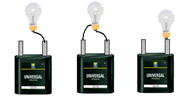

Q2. We have two batteries
and one light bulb connected as indicated in the figure.
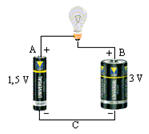
Yes |
No
|
Don’t know |
|
| a) Is there a difference in potential between points A and B? | |||
| b) Does current flow through the bulb? | |||
| c) Does current flow through cable C? |
Q3. In the circuit shown in the figure we have one battery, two equal light bulbs A and B, and a resistor R inserted between the two light bulbs.
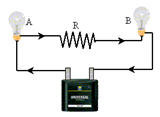
Indicate which of the following
situations will be produced, and give a short explanation.
a) Bulb B will give off more light than bulb A.
b) The two bulbs will give off the same amount of light.
c) Bulb A will give off more light than bulb B.
Q4. Of the following situations, tell which one correctly explains what happens
with the electric current:
a) The current comes from one pole of the battery and is used up in the light
bulb.
b) The current comes out of one pole of the battery, passes through the light
bulb, and less current returns to the battery, entering through the other pole.
c) The current comes out of one pole of the battery, passes through the light
bulb, and the same current enters by the other pole.
d) The current comes out of both poles of the battery and is used up in the
light bulb.

Q5. Inside a flashlight
there are three batteries placed as indicated in the figure. When we turn the
flashlight on and the bulb shines:
a) Is there current going through the batteries?
yes ![]() no
no ![]()
b) If yes, then through which battery does the most current flow?
A ![]() B
B ![]() C
C ![]() all the same current
all the same current ![]()

Q6. We have a metal bar AB with resistance, connected to a battery by two conductor cables without resistance.
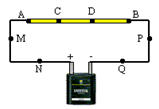
Is there a difference in potential between the pairs of points indicated below?
| a) between A and B | yes
|
no
|
| b) between C and D | yes
|
no
|
| c) between M and N | yes
|
no
|
| d) between P and Q | yes
|
no
|
Q7. In the following circuits all the light bulbs and batteries are the same.
Which light bulbs will give off more light? Which will give off less? Put them
in order from more to less.

Q8. In the following circuit all the light bulbs are the same.

a) Which bulbs will give
off more light?
b) Which bulbs will give off less light?
We disconnect light bulb B3 from the circuit and put nothing in its place.
c) Will bulb B2 shine more,
less, or the same as before?
d) And light bulb B1?
Q9. We have a circuit made up of a battery, two light bulbs M and N, and two resistors. If we disconnect light bulb N and put nothing in its place, explain:
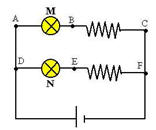
a) How will the potential
difference vary between points D and E?
b) How will the brightness of bulb M change?
(Comment on the variations regarding the first situation, when bulb N was still
connected).